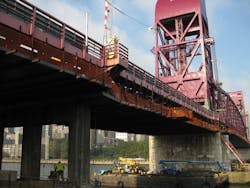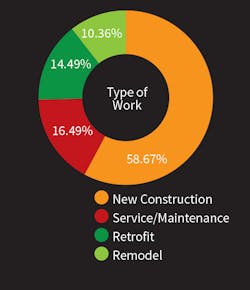2017 Book of Giants: Workforce crisis turns contractors into manufacturers
This year I asked major mechanicals a question that is different from what I usually ask the Giants: What is their and the industry’s biggest problem and what is the big solution? The problem, they said, is the lack of skilled labor, much as it is for the entire industry. The big solution is to turn to a manufacturing approach that uses as little labor as possible. It’s a high-tech solution that requires a considerable investment and may leave small- to medium-size mechanicals struggling to keep up.
It has always made sense for mechanical contractors to prefabricate anything that’s repetitive in a building, such as the behind-the-wall plumbing and fixture carriers for office building restrooms. The shortage of skilled workers, however, has some large mechanical contractors fabricating large assemblies built to exacting tolerances that are shipped to the jobsite and installed with as little labor input as is practical.
Click here for our list of the Top 100 Mechanical Contractors
Click here to see our revenue breakdown of the Top 50
BIM, schedule rule
Opportunities for new work are abundant across the country and most contractors’ backlogs are growing, says Tim Moormeier, president of U.S. Engineering in Kansas City, Missouri.
“The flip side of that is that we have a limited labor force and our work tends to be seasonal because of the nature of HVAC work,” Moormeier says. “There’s a lot of work and not enough field labor to execute it. It’s a perfect storm of great work opportunities and not enough qualified field leaders and field plumbers, pipefitters and sheet metal workers to complete the work on time and with the kind of productivity that you want. We experienced it directly during the last two summers and we worry about this summer. Our big solution is to manufacture more of our work to the point that we manufacture the vast majority of it.”
If you’re still performing work like you did 10 years ago, there’s no way you can get it done today.— Denny Terrell, Ivey Mechanical
Mechanicals have a tough time throwing 300 guys at a job. Contractors, consequently, have to transfer brainpower to planning rather than installation, says Philip Catanzaro, president of Bernhard MCC Mechanical, Baton Rouge, Louisiana.
“The paradigm change involves shifting scheduling, energy, and resources fromDenny Terrell, president of Ivey Mechanical Co., Kosciusko, Mississippi, says Ivey has invested more than a half million dollars over the past two to three years in four fabrication shops.
“If you’re still performing work like you did 10 years ago, there’s no way you can get it done today,” Terrell says.
Ivey set up shops in four buildings on the same property, a plumbing shop, a pipe shop, a heavy metal shop and sheet metal shop. “Heavy metal” fabricates pieces such as hoods, trench drains and hangers. Ivey will ship assemblies all over the Southeast, but for larger projects it may also lease space somewhere close to the jobsite for prefabrication of smaller repetitive items such as VAV hookups.
Manufacturing investment
U.S. Engineering has gone all-in. “We have in excess of 250,000-sq.ft. of manufacturing at this point,” Moormeier says, “and the largest capital investment the company has made in its history is our new manufacturing facility in our Denver market that came online last fall. It is extremely busy and is at the core of our strategy. Four years ago we bought a manufacturing facility in the Kansas City market and it’s already outpacing its ability. We’re continuing to evaluate where we make those investments. It requires advanced machinery that’s very expensive and the technology to feed that operation.”
The manufacturing model breaks down silos in the design, planning and fabrication process, he explains. Departments and functions can’t be segregated.
What estimating and what design engineering and what the CAD operator and what theBernhard MCC has taken a similar path, Catanzaro says. The majority of the firm’s pipe, plumbing, and sheet metal fabrication has been consolidated into one location. The facility has the space that allows process flows that can be staffed and monitored for safe and cost-effective production of fabricated components. Assemblies include plumbing fixture batteries, equipment skids, 2D and 3D modularized racks, and sectioned ductwork, with all of the palletized fabrication organized and tagged for specific areas of a job. Everything that can be measured, cut, assembled and shipped for simpler installation at the jobsite is considered.
Close tolerances
“The BIM Model is the key ingredient in our process,” Catanzaro says. “Everything that we fabricate is extracted from the BIM Model, which is coordinated with the other crafts on the said projects. So, in turn, we build it virtually, spool it with our dedicated group, then fabricate it.”
While manufacturing reduces field labor, it requires a lot of skilled people in the design and planning stages.
Bernhard MCC, which aims to fabricate to a tolerance of 1/16-inch, also specifies the manufacturer and model number of every piece that goes into the model. The contractor has a centralized purchasing group that works with the project teams and estimating to develop a “material matrix.” They use that material matrix to solidify exactly which manufacturers of all components it plans to use prior to detailing and fabrication.
“Your best opportunity to manage field labor requirements is to get involved earlier in projects and try to level that peak push, but you only can do that if you’re allowed to plan the job,” Moormeier says. “When we start looking at projects with a hard bid and the design is complete and they want us to start two weeks later, that’s a bad project for us. We can’t execute our strategy and deliver the value to the project that we’d like to. It limits any mechanical contractor’s ability to deliver a project to the owner. We try to talk to owners and reason with them about why you want the subs involved earlier so that you get more value out of that process. You have more certainty of the price of project and more confidence that it can be delivered on or ahead of schedule. And you’ve got to show them through real projects that it actually plays out that way.”
That also requires general contractors who hold the schedule sacrosanct, especially when large assemblies have to be moved through the jobsite. If one of the subs asks, for example, to install something early, the GC has to be able say no.
Vigorously recruiting
The focus on fabrication aside, the contractors are still vigorously recruiting. Ivey’s Terrell says he’s short of superintendents and craftspeople.
Ivey has hired a full-time craft trainer and a recruiter who is trying to develop better relationships with staffing services and recruiters. The company ramping up its apprenticeship program, doing in-house mentoring, and is working with community colleges. The problem is that it takes a long time to train a qualified welder or pipefitter, Terrell notes.
Catanzaro says that Bernhard MCC will hire a full-time craft-recruiting manager nationally. Additionally, the company has increased exposure through outreach at various schools, vo-techs, high schools, job placement assistance agencies, disabled worker assistance agencies, veterans’ agencies, veterans’ re-employment schools, re-entry court programs, youth programs, as well as female and minority associations.
The company is also pursuing people with mechanical aptitude who are already working or have been recently laid off.
“In addition to commercial MEP, we currently target industrial and residential skilled-craft workers, temp workers, retirees, mechanical service and maintenance workers, trained but inexperienced workers, experienced helpers than can be trained up or enrolled in an apprenticeship program, and even sales, safety and other professional positions that started out in a trade,” Catanzaro says.
“As we move more into modeling and planning in construction, there has been an increasing need for individuals that are comfortable with 3D technology,” Catanzaro says. “Unfortunately, those individuals generally don’t possess the trade knowledge necessary to understand the components and complexities associated with building a job. Therefore, it has been necessary to take some of the more experienced craftsman in the field and blend their knowledge with the technology to produce an effective and coordinated virtual product that can move into purchasing, fabrication, and installation.”
As advanced planning and manufacturing become more common, it creates a conundrum for small- to medium-sized mechanical contractors. It takes a lot of money to invest in the plant and equipment and the BIM and CAD/CAM technology, plus the highly skilled people necessary to make this all work.
Moormeier says that the manufacturing approach is scalable up or down, but it still requires an investment, especially in the right people.
Contractor management will have to decide if they can prosper with smaller construction projects and mechanical service work or if they have to change their whole approach to constructing buildings.
About the Author
Robert P. Mader
Bob Mader is the Editorial Director for Penton's mechanical systems brands, including CONTRACTOR magazine, Contracting Business and HPAC Engineering, all of which are part of Penton’s Energy and Buildings Group. He has been with CONTRACTOR since 1984 and with Penton since 2001. His passions are helping contractors improve their businesses, saving energy and the issue of safeguarding our drinking water. He is a graduate of the University of Notre Dame with an A.B. in American Studies with a Communications Concentration.






